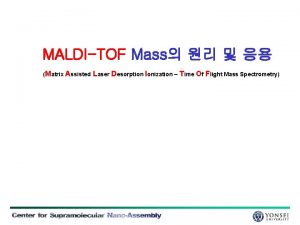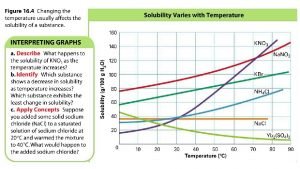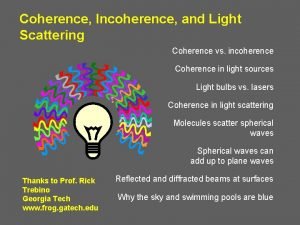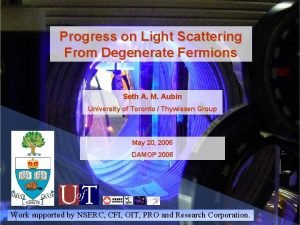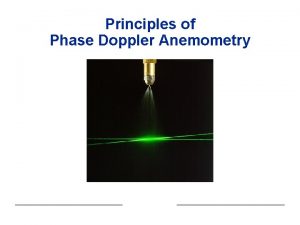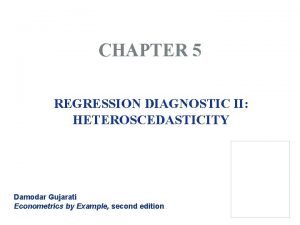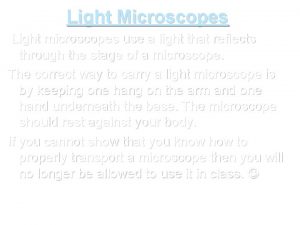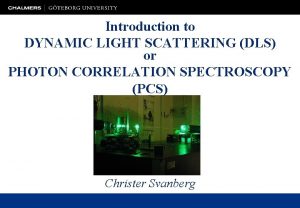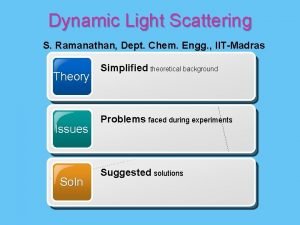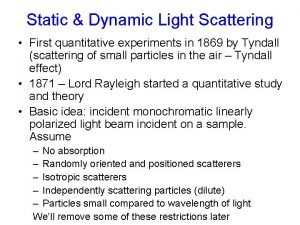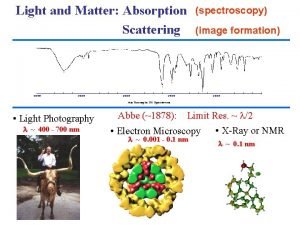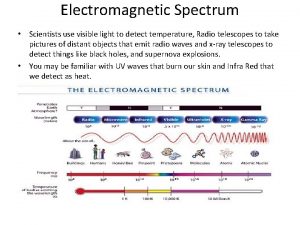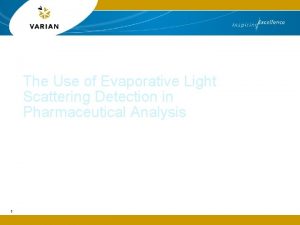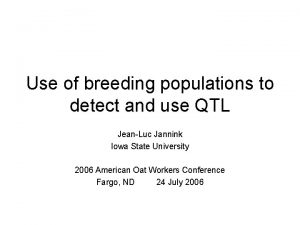Use of Dynamic Light Scattering to Detect the






















- Slides: 22

Use of Dynamic Light Scattering to Detect the Growth of Amyloid Fibrils in HEWL.

What are they? Why should we study them? • Proteins bonded in a very specific manner • How they are formed is not understood • Associated with many diseases, including: – Alzheimer’s Disease – Mad Cow Disease

Hen Egg White Lysozyme • In water, HEWL is in folded state – Hydrogen bonding • TFE partially unfolds, then stabilizes HEWL • Newly exposed portions of HEWL should bond to each other, forming strands

How Could We Study Them? • We wanted to characterize their rate of formation • Disturbing the proteins would make any data collected questionable • How could we solve this problem?

Dynamic Light Scattering!

What is DLS? • Detects the changing interference pattern of laser light scattered by small particles in solution. • From the rate of change, we can measure the diffusion rate and size of the particles.


Light Scattering in Action!

What is the Autocorrelation Function? • Put simply: the average of the time varying portion of the intensity at some initial time, t, with the time varying portion of the intensity at some later time, t+∆t.

OK, It isn’t really that simple… • This calculation is done for many values of ∆t. • It is repeated many times (in our case, ~400), each time averaging the new result with the average of all the previous results.

Why would you do that? • For small values of ∆t, the signal is still correlated with the signal at t = 0; positive average intensity. • For large values of ∆t, this is not true, and the autocorrelation function will eventually average out to zero.

Key Point • By measuring how long it takes the function to go to zero, we can tell how fast the particles are moving!

For All You Visual Learners…

Microsphere Autocorrelation Function, τ = 3. 89 ms.

Single Exponential Autocorrelation Function

Multiple Exponential Autocorrelation Function

Multiple exponential fit

Evolution of the Autocorrelation Function

Time Constants Vs. Incubation Time

In Conclusion • Succeeded in producing a DLS setup • Induced aggregation in HEWL with TFE • Unable to prove that aggregate contained Amyloid Fibrils • With more time, experiment could be completed

Special Thanks Dr. Stephen Hagen Dr. Robert De. Serio Caleb Carswell University of Florida Physics Department

(Applause)
 Dynamic light scattering 원리
Dynamic light scattering 원리 Liquid crystal display
Liquid crystal display Scattering of light in suspension
Scattering of light in suspension Scattering of light definition
Scattering of light definition Rayleigh and mie scattering
Rayleigh and mie scattering Rayleigh theory of light scattering
Rayleigh theory of light scattering Rayleigh theory of light scattering
Rayleigh theory of light scattering Rayleigh theory of light scattering
Rayleigh theory of light scattering Pauli blocking of light scattering in degenerate fermions
Pauli blocking of light scattering in degenerate fermions Scattering of light
Scattering of light Phase doppler anemometry
Phase doppler anemometry Light scattering
Light scattering Light light light chapter 23
Light light light chapter 23 Into the light chapter 22
Into the light chapter 22 Light light light chapter 22
Light light light chapter 22 Dynamic dynamic - bloom
Dynamic dynamic - bloom Intrusion.win.ms14-068.ta
Intrusion.win.ms14-068.ta How to detect iridium in gold
How to detect iridium in gold How to detect heteroscedasticity
How to detect heteroscedasticity Stack based overflow
Stack based overflow To detect the presence of adulterants in sugar project
To detect the presence of adulterants in sugar project Heteroscedasticity
Heteroscedasticity Detect protect perfect
Detect protect perfect
